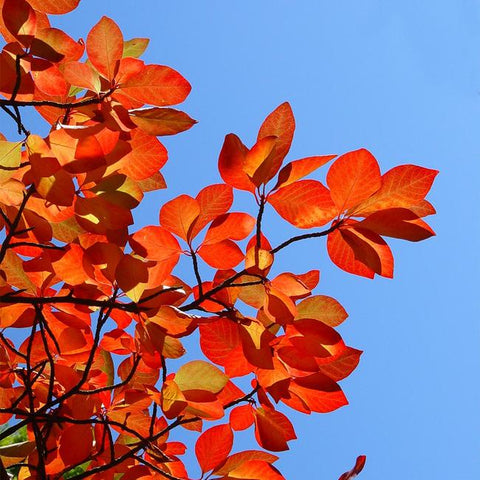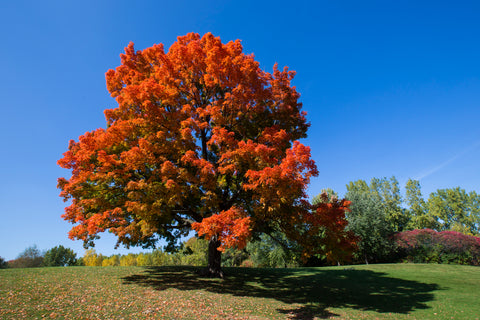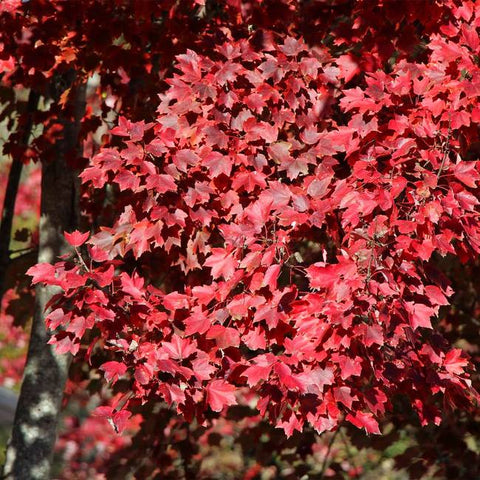Oh my gosh, it’s November. Where did October go? My favorite time of year is the fall (but ask me that question again in the spring, and you may get a different answer). It's when beautiful summer flowers and shrubs fade, and the trees take center stage. The weather is cooling down, bringing with it a time of planting, adding to, removing, and rearranging the yard.
Trees are the crowning glory of our fall landscapes, and color is in the spotlight - so let’s talk color. Here, I'll share a few of my favorite trees for fall color.
Black Tupelo (Black Gum Tree)
Black Tupelo (also know as Black Gum, or Sour Gum) is one of the first trees to show color. It becomes a solid mass of bright red - but on the way to red, it can turn purple, yellow and orange.
This tree is native in many areas of the United States, and grows best in well drained soil. It grows 12 to 24 inches a year, to a height of 30 to 50 feet. The spread of the Tupelo can be up to 20 to 30 feet - so make sure it is planted at least 50 feet from your house!

Bright fall foliage on the Green Gable Tupelo (Black Gum Tree)
I love the bark on this tree. As it grows, it reminds me of alligator hide. Not only is this tree beautiful - but it also feeds wildlife with small bluish-black fruit! More importantly, it is nutrition for the bee population in the spring. If you have room in your yard, this is a perfect tree to consider planting.
Ginkgo Tree
The Ginkgo tree is one of my favorite trees for all seasons. But we are talking about fall color - and this tree certainly makes its mark when the beautiful, fan-shaped leaves turn a brilliant golden yellow against cracked brown bark.

The Ginkgo Tree has beautiful, fan-shaped foliage that turns vivid yellow.
And they're an incredibly strong tree. In 1945, the atomic bomb was dropped on Hiroshima, leveling biological and manmade landmarks. If you can believe it, the Ginkgo was able to survive, and are actually still living in that area today. If you have trouble keeping trees alive, maybe this is the tree for you!
Native to China, this tree grows in zones 4 through 9. They are disease-resistant and tolerate urban pollution. They will generally grow 25 to 50 feet tall, with a 25 to 35 foot spread. The Ginkgo can live for thousands of years - the oldest on record is 3,500 years old. Talk about planting for the future!
Sugar Maple Tree
When it comes to the most stunning color, the Sugar Maple has to be right up there. As the fall progresses, it turns yellow, burnt orange and then red. And did you know? More states have claimed this tree as their state tree than any other species!
This Maple tolerates soggy soil, drought, and even some shade. It's not only planted for its wonderful maple syrup, but for its valuable hardwood lumber, too. It grows 60 to 75 feet tall, with a 40 to 50 foot spread, in zones 3-9. A word of caution - if you plant this beautiful tree, don’t even try to plant grass under it. The tree will always win!

Sugar Maples are known for their blazing orange-red color in fall.
Red Maple Tree
Another maple that I love (I really have not met a maple I don’t love!) is the Red Maple. The fall color really shines, with deep red and yellow. It grows from Maine to Minnesota, south to Texas and east to Florida. It is native to the eastern forest, growing from zones 3 to 9 at a medium-fast rate.
It prefers damp soil conditions and only has slight drought tolerance. When happy, it can grow to 90 feet tall and 40 feet wide. It feeds squirrels and other rodents (that's not much of a selling point for me, but I still love it).

The dark red foliage of the American Red Maple.
I can go on and on about the beautiful colors of fall. As you ride or walk around, notice the beautiful colors, decide which would look best in your landscape and consider the mature size of the tree.
Now is the time to purchase these beauties. Depending on where you live, there is still time to plant a tree. In many areas, it may get cold but the ground does not freeze, so planting season can go on for many months.
If you live in an area that freezes, preventing outside work after November, enjoy your vacation from the duties of the garden - and dream of things to come in the spring!

